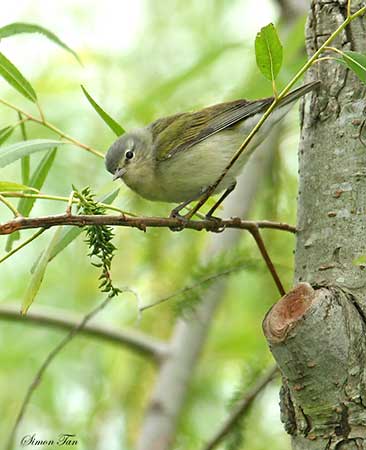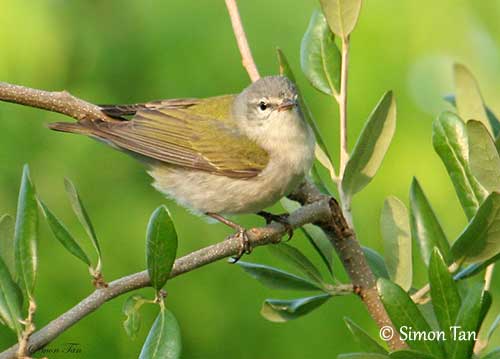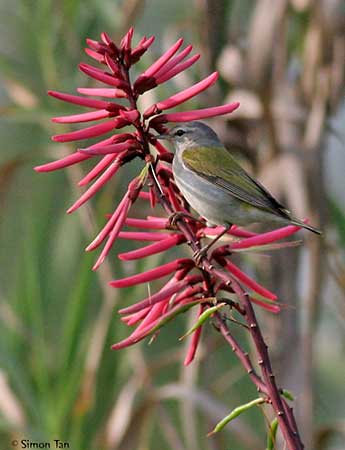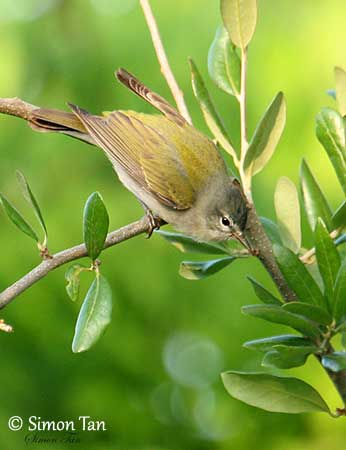
Fr: Paruline obscure
Ang: Tennessee Warbler
All: Brauenwaldsänger
Esp: Reinita de Tennessee
Ita: Parula del Tennessee
Nd: Tennesseezanger
Sd: tennesseeskogssångare
Photographer:
Simon Tan
PBase Bird galleries
Text by Nicole Bouglouan
Sources:
HANDBOOK OF THE BIRDS OF THE WORLD Vol 15 by Josep del Hoyo-Andrew Elliot-David Christie - Lynx Edicions – ISBN: 9788496553682
A GUIDE TO THE BIRDS OF MEXICO AND NORTHERN CENTRAL AMERICA by Steve N. G. Howell, Sophie Webb - Oxford University Press - ISBN: 0198540124
A GUIDE TO THE BIRDS OF COLOMBIA by Steven L. Hilty and William L. Brown - Princeton University Press – ISBN 069108372X
FIELD GUIDE TO THE BIRDS OF NORTH AMERICA - National Geographic Society - ISBN: 0792274512
THE HANDBOOK OF BIRD IDENTIFICATION FOR EUROPE AND THE WESTERN PALEARCTIC by Mark Beaman, Steve Madge - C.Helm - ISBN: 0713639601
Avibase ( Denis Lepage)
Birdlife International
All About Birds (Cornell Lab of Ornithology)
Wikipedia, the free encyclopaedia
Neotropical Birds – Cornell Lab of Ornithology
What Bird-The ultimate Bird Guide (Mitchell Waite)
Bird Web (Seattle Audubon Society)
The Birds of North America online
Houston Audubon Society (National Audubon Society)
Tennessee Warbler
Leiothlypis peregrina
Passeriformes Order – Parulidae Family
INTRODUCTION:
The Tennessee Warbler was discovered in 1811 by the ornithologist Alexander Wilson. This species was named from a specimen collected in Tennessee, but it does not occur in this state or only briefly during migration.
It breeds in the northern parts of North America and winters in Central America. This warbler is plump and short-tailed, but it has a long-straight bill.
It feeds on insects during the breeding season, caught in coniferous, mixed or deciduous forests. During winter, it consumes fruits, berries, nectar and also insects and it frequents second growths, forest edges and wooded areas with flowering trees.
The Tennessee Warbler is a long-distance migrant. It is flairly common throughout the breeding range, but the population locally rises and falls depending on food resources.
But currently, the species is not globally threatened.

DESCRIPTION OF THE BIRD:
Biometrics:
Length: 12 cm
Wingspan: 20 cm
Weight: 8-13 g
The Tennessee Warbler adult male in breeding plumage has pale bluish-grey head and nape, but face and neck are mostly pale grey. There is a whitish eyestripe just above the blackish eyeline.
On the upperparts, wings, back and rump are olive-green, slightly darker on wings and tail.
The underparts are whitish from chin to undertail-coverts. Wings and tail feathers are dark grey. Breast and flanks may show a pale yellowish wash.
The bill is blackish. The eyes are dark brown. Legs and feet are grey with brownish tinge.
The male in non-breeding plumage is duller overall. Head and nape are greyish-green like rest of upperparts. On the underparts, throat and breast show variable yellowish wash, whereas belly and undertail-coverts are whitish.
The female in breeding plumage resembles male but she is duller, with head washed olive, while supercilium and underparts are washed yellowish, especially on breast.
The female in non-breeding plumage is duller. She has more yellow below, especially on belly and flanks.
The juvenile resembles non-breeding female but it is darker green and duller. On the head, the eyeline is much paler and the eyestripe is dusky. There are two indistinct wingbars on the upperwing.
The underparts are pale yellow with darker upper belly and flanks. Bill, legs and feet are pinkish-buff.
RANGE:
The Tennessee Warbler breeds in Canada (Yukon and British Columbia, E to Newfoundland and Nova Scotia), and NE USA (S to N New England). It rarely occurs in SE Alaska and NW Montana.
It migrates and spends the winter from S Mexico, through Central America and S to NW South America, with a few in W Caribbean.

HABITAT:
The Tennessee Warbler breeds in a variety of coniferous, mixed and deciduous forests with dense understorey and herbaceous vegetation.
It is mostly found high in trees during spring migration, but lower in brush or weedy fields during fall migration.
It winters in open second growth forest and at forest edge, in coffee plantations, gardens and wooded areas with flowering trees.
This species can be seen from sea-level to 2,300 metres of elevation, but also up to 3,000 metres in Costa Rica. But it is usually most common in foothills.
CALLS AND SONGS: SOUNDS BY XENO-CANTO
The Tennessee Warbler’s calls include a short-rasped “zik” and a thin “zeep”.
The song is distinctive, a fairly loud, sharp series of two-syllable notes followed by slightly higher-pitched single notes and ending in trill “sidit-sidit-sidit-sidit-swit-swit-swit-swit-sit-sit-sit-sit-sit”.
BEHAVIOUR IN THE WILD:
The Tennessee Warbler feeds primarily on insects during the breeding season, such as caterpillars, aphids, beetles, flies, ants and others, and it also takes spiders. In addition, it feeds on nectar and some juice from grapes.
On the wintering grounds, it feeds mainly on nectar, berries and fruits, and gets proteins from base of leaves of Cecropia trees.

The Tennessee Warbler forages high up in trees during summer, and lower down outside breeding season. It usually feeds by hanging upside-down to glean from undersides of leaves.
During spring, it takes nectar from flowers and catkins. During summer, the male forages mostly in treetops whereas the female remains close to the ground. Large flocks of up to 200 individuals can be seen in coffee plantations during winter.
During the breeding season, the Tennessee Warbler male gives loud, repetitive songs on its territory. It performs a song-flight during courtship, up to 18-20 metres above the ground.
The Tennessee Warbler is a long-distance migrant. It leaves the breeding areas between mid-August and late August to reach the wintering grounds. The return migration starts in early April. They arrive from mid-May on the breeding grounds.
This species is vagrant in Chile, Lesser Antilles, W Alaska, Greenland and Europe (Britain, Faeroe Islands and Iceland).
The Tennessee Warbler has weak fluttering flight with shallow wingbeats.

REPRODUCTION OF THIS SPECIES:
The breeding season takes place between June and August, with the laying in June-July. This species usually produces a single clutch, rarely two. However, a replacement clutch may be laid if the first fails.
The Tennessee Warbler builds a cup-shaped nest with grasses. It is lined inside with softer grasses and rootlets. This structure is concealed in a depression on the ground, usually under bushes or overhanging grass. It is built by the female on mossy hummock in a wet area, but this warbler may also nest on drier ground on steep hillsides.
The female lays 4-7 white eggs with some dark markings. She incubates alone during 11-12 days and the chicks leave the nest about 12 days after hatching.
The nest may be parasitized by the Brown-headed Cowbird in some parts of the breeding range.
PROTECTION / THREATS / STATUS:
The Tennessee Warbler is fairly common or abundant throughout the range, but the numbers usually vary depending on food resources, and especially spruce budworms.
The population has probably increased overall since 1800s, but destruction of the spruce budworms which is its preferred food may have recently caused some local declines.
The Tennessee Warbler is considered not globally threatened, and it is currently evaluated as Least Concern.
